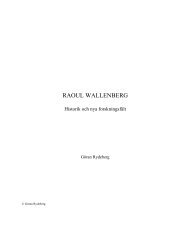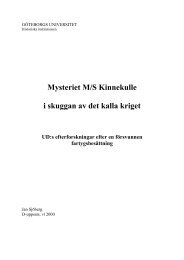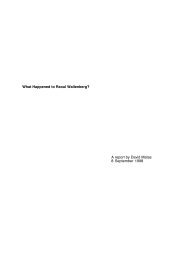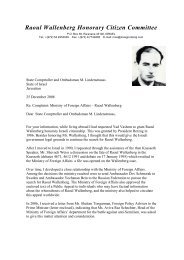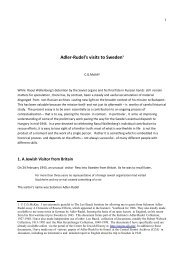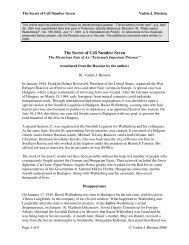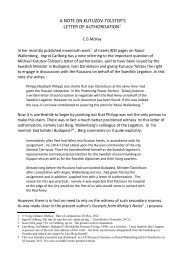raoul wallenberg swedish humint actions during ww2 - Searching for ...
raoul wallenberg swedish humint actions during ww2 - Searching for ...
raoul wallenberg swedish humint actions during ww2 - Searching for ...
Create successful ePaper yourself
Turn your PDF publications into a flip-book with our unique Google optimized e-Paper software.
We can assume that almost as soon as he came into contact with Red Army units in Pest on<br />
about 14 January 1945, he presented at least some outline of his plans. What is also evident<br />
from later testimonies by Soviet military leaders – most importantly those presented in the<br />
Russian files released in the 1990s – is that after having been found by the Soviet army units,<br />
Wallenberg was escorted by these <strong>for</strong> several days when continuing to work on his mission.<br />
/Cf. documents C 6-10 from TsAMO, the Defence Ministry in Moscow. UD P2 Eu 1 ./<br />
He was probably allowed some liberty of action, though the documents indicate that he was<br />
prohibited to make any contact with the outer world. We do not know whether Wallenberg<br />
was aware of his situation. Notably, he was not in<strong>for</strong>med that the Soviet government had<br />
ordered his arrest on 16 January and he was probably unable to realise that his new “friends”<br />
were hostile to his mission. His <strong>actions</strong> imply that he was not aware of their intentions. He<br />
could not have <strong>for</strong>eseen when he was told that he would be able to visit the Soviet<br />
headquarters in Hungary on 17 January that the Soviet authorities had totally different plans<br />
<strong>for</strong> him. We know that he took some important documents with him when he went, such as<br />
his passports (a normal passport and a diplomatic one), telephone book and calendar and<br />
probably some other items. It was of course his intention to show these documents, but he<br />
could not <strong>for</strong>esee the outcome of this.<br />
What did the Soviet authorities find out about the diplomat in captivity and how did they<br />
interpret the in<strong>for</strong>mation they obtained? First of all, they probably wanted to know more about<br />
Wallenberg’s mission. They must soon have become aware that he had quite a free role, that<br />
he had quite a lot of money and not least that the organisation he was obviously the head of<br />
was much larger than would have been expected of a young, inexperienced, subordinate<br />
representative of a very small country. The fact that the Swedish flag was seen on many<br />
houses in Pest when the Red Army units arrived was probably also perplexing. Wallenberg<br />
probably explained the circumstances by in<strong>for</strong>ming the Soviet representatives that Sweden<br />
owned the buildings and provided shelter and lodging there <strong>for</strong> the refugees that were<br />
protected by the country. This of course was another indication that Sweden and Wallenberg<br />
had quite a lot of money <strong>for</strong> their mission.<br />
The Soviet authorities started investigating the in<strong>for</strong>mation and were greatly concerned about<br />
what had been going on in the buildings.<br />
We have some indications of how the Soviet authorities interpreted the facts. The testimony<br />
of the <strong>for</strong>mer representative of the Hungarian Red Cross, Aron Gábor, is one example. /UD P2<br />
Eu 1 16 Oct. 1965, especially pp. 8-12./ This in<strong>for</strong>mation, given in 1965, provides us with many<br />
insights into the work done by Wallenberg. Gábor stated on this occasion that he was arrested<br />
and imprisoned by the Soviet authorities in Budapest in autumn 1945. Gábor claimed that he<br />
had told the Soviet authorities that he had neither worked <strong>for</strong> Wallenberg’s mission nor did he<br />
have any particular knowledge of Sweden. Nevertheless, his story was totally rejected by the<br />
interrogators and they instead presented the following accusations against him and the<br />
Swedes:<br />
• Hungarian officers loyal to the regime had been able to use the Swedish houses in<br />
Budapest as “spy centres” and in so doing had acted against the interests of the Soviet<br />
Union.<br />
• The Swedish Red Cross representatives provided the Hungarians with in<strong>for</strong>mation<br />
concerning Soviet troop movements.<br />
• There was evidence that Swedish houses were used as illegal weapons depots.<br />
The most significant accusation, however, was that<br />
14




